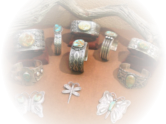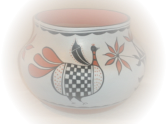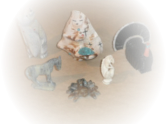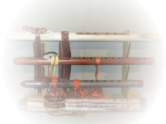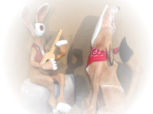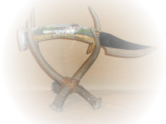





Oldest House Indian Shop
Barrio De Analco Historic District
215 E. De Vargas St.
Santa Fe. NM 87501
505-988-2488
inquiry@oldesthouseindianshop.com
Open 9:00 am - 6:00 pm every day
Closed Easter, Thanksgiving and Christmas
…where the past lives on…




Timeless Treasures







The
Oldest
House
Indian
Shop
at
215
East
De
Vargas
St.
in
Santa
Fe
is
the
new
home
of
the
Indian Shop at La Fonda, a Santa Fe retail destination for 27 years.
“We
are
very
excited
to
be
at
the
Oldest
House,”
says
owner
Rick
Smith.
“This
location
is
steeped
in
layers
of
history
dating
back
to
the
1200s.
Here
our
love
of
the
timeless
treasures
created
in
the
spirit
of
the
cultures
of
Santa
Fe,
New
Mexico
and
the
Southwest
combines
with
a fascinating community history spanning eight centuries.”
The
Oldest
House
Indian
Shop
welcomes
visitors
into
the
Oldest
House
Museum
in
the
National
Historic
Landmark
Barrio
de
Analco
Historic
District,
one
of
the
oldest
residential
neighborhoods
of
European
origin
in
the
United
States.
A
part
of
the
Spanish
barrio
originally
settled
in
1620,
the
Oldest
House
is
also
believed
to
rest
on
part
of
the
foundation
of
an
ancient
Indian
Pueblo
built
in
the
1200s.
The
New
Mexico
Tourism
Department
includes
the
Oldest House on its list of 15 must-see adobe structures.
Smith’s
passion
for
sharing
Native
American
and
Western
collectibles
shines
through
in
the
richly
diverse
pieces
he
offers.
His
cases
are
packed
with
the
work
of
notable
potters,
jewelers,
carvers
and
Native
American
flute
makers,
and
his
knowledgeable
staff
members
are
happy
to
tell
the
stories
behind
the
pieces.
The
Oldest
House
Indian
Shop
features
renowned
artists
including
jewelers
Murphy
Platero
and
Ray
Scott,
Kachina
carver
Alton
Honahni,
flute
makers
Brent
Haines
and
Colyn
Petersen,
folk
artist
Rory
Alvarez
and
potters
Robert
Tenorio
and
Madeline
Naranjo.
Along
with
his
top-tier,
distinctly-curated
pieces,
Smith
offers
intriguing
curios for every collector’s budget.
“The
pieces
we
offer
in
the
Oldest
House
Indian
Shop
are
touchstones
to
a
moment
or
an
experience,”
Smith
says.
“They
are
things
that
spark
the
imagination
and
encourage
curiosity
and exploration. Here we provide a venue for the joy of being in Santa Fe.”



Copyright 2017 Oldest House Indian Shop


Welcome

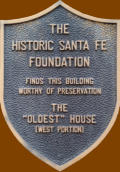
Jewelry
Pottery
Fetishes
Gifts
Flutes
Arts & Crafts

The History
De Vargas Street House “The Oldest House”
De
Vargas
Street
House
located
at
215
E.
De
Vargas
Street
on
the
eastern
side
of
Old
Santa
Fe
Trail
in
Santa
Fe,
New
Mexico
within
the
Barrio
De
Analco
Historic
District
,
is
one
of
the
oldest
buildings in America.
The
Oldest
House
rests
on
part
of
the
foundation
of
an
ancient
Indian
Pueblo
dating
from
around
1200
CE.
This
pueblo
was
once
inhabited
by
a
tribe
from
the
Tano
speaking
tribes
of
the
northern
part
of
the
territory.
Sometime
around
1435
CE,
this
tribe
abandoned
their
village,
moving
on
to
other
sites
farther
south
in
search
of
water,
better
fields
or
hunting
grounds.
In
1598,
Don
Juan
de
Onate
led
a
party
of
Spanish
settlers
into
the
area
in
search
of
a
suitable
place
to
establish
a
permanent
settlement.
Accompanying
Onate
were
Tlaxcalan
Indian
warrior
auxiliaries.
The
small
band
seems
to
have
gravitated
to
their
own
ward,
or
barrio,
soon
known
as
El
Barrio
de
Analco
at
the
same
time
La
Villa
Real
de
Santa
Fe
de
San
Francisco
de
Asisi
was founded in 1608.
The
Tlaxcalans
found
the
river
site
met
their
every
need.
The
river
provided
ample
water
for
irrigation
of
cornfields
to
the
south
ot
the
San
Miguel
Church
and
an
abundance
of
sweet
tasting
stream trout to grace their tables.
During
the
Great
Pueblo
Rebellion,
the
Indians
of
the
Barrio
de
Analco
suffered
greatly.
Their
homes
were
sacked
and
burned
with
a
heavy
loss
of
life.
The
survivors
retreated
across
the
river
and
joined
the
Spaniards
in
a
spirited
but
successful
defense
of
the
Villa.
The
Spanish
withdrew
from
the
Villa
with
the
Tlaxcalans.
Only
a
few
of
the
first
Tlaxcalans
are
believed
to
have returned to Santa Fe after the reconquest by Don Diego de Vargas in 1692-1693.
Between
1709-1710
the
“Oldest
House”
became
temporary
residence
to
Spanish
Territorial
Governor
Chacon
Medina
Salazar,
Marquez
de
Penuela,
while
repairs
were
being
made
to
the
San Miguel Church.
By the late 1800s, genizaros or acculturated plains Indians such as the
Apaches
and
Navajos,
as
well
as
the
families
of
Spanish
soldiers
were
living
in
the
Barrio.
Up
until
the
1920s
the
Oldest
House
was
continually
occupied
by
people
representing
all
the
cultures of Santa Fe.
Barrio De Analco Historic District
The
National
Historic
Landmark
Barrio
De
Analco
Historic
District
in
Santa
Fe,
New
Mexico
is
one
of
the
oldest
residential
neighborhoods
of
European
origin
in
the
United
States.
Originally
settled
in
1620
by
the
Spanish,
Barrio
(or
District)
de
Analco
suffered
major
destruction
during
the
1680
Great
Pueblo
Revolt.
The
Spanish
rebuilt
Analco
beginning
in
1692
during
their
recolonization
of
New
Mexico.
The
buildings
of
Analco
are
in
the
Spanish
Pueblo
and
Territorial
styles
that
reflect
the
merger
of
Spanish,
Indian
and
eventually
American
building
techniques.
In
the
seven
adobe
brick
buildings
that
make
up
the
Barrio
de
Analco
Historic
District
visitors
can
see
how
working-class
Spanish
colonists,
Tlaxcalan
Indians
and
other
American
Indians
lived
in
Santa Fe during the late 17th and early 18th centuries.
The
Spanish
first
settled
Santa
Fe
during
the
winter
of
1609-1610
as
they
sought
to
“civilize”
the
North
American
continent
and
to
expand
their
New
World
empire.
Mirroring
other
Spanish
colonial
settlements
of
the
era,
the
colony
in
Santa
Fe
was
a
defensible
fort
and
village
set
around
a
central
plaza.
Also
featured
in
this
itinerary,
the
Santa
Fe
Plaza
became
the
commercial,
social
and
political
center
of
the
community.
Fearing
attacks
from
the
local
Pueblo
Indians,
many
high-ranking
Spanish
officials
and
citizens
built
their
homes
around
the
plaza
because it was a central defendable area.
As
Santa
Fe
prospered,
the
original
settlement
expanded
to
include
growing
neighborhoods
on
the
opposite
side
of
the
Santa
Fe
River
from
the
plaza.
By
1620,
the
newly
constructed
Chapel
of
San
Miguel
was
in
place
and
a
suburb,
the
Barrio
de
Analco,
began
to
grow.
The
Tlaxcalan
Indian
word,
“Analco,”
means
“the
other
side
of
the
river,”
which
distinguished
this
barrio
from
the
neighborhood
on
the
plaza
side
of
the
Santa
Fe
River
where
government
officials
and
other
prominent
citizens
resided
and
attended
mass.
The
Chapel
of
San
Miguel
provided
laborers,
artisans and Tlaxcalan Indian servants with a place to worship in the growing suburb.




Print

Paintings
Norman Akers
Oldest House Indian Shop
Barrio De Analco Historic District
215 E. De Vargas St.
Santa Fe. NM 87501
505-988-2488
inquiry@oldesthouseindianshop.com
Open 9:00 am - 6:00 pm every day
Closed Easter, Thanksgiving and Christmas
…where the past lives on…


Timeless Treasures
Welcome
The
Oldest
House
Indian
Shop
at
215
East
De
Vargas
St.
in
Santa
Fe
is
the
new
home
of
the
Indian Shop at La Fonda, a Santa Fe retail destination for 27 years.
“We
are
very
excited
to
be
at
the
Oldest
House,”
says
owner
Rick
Smith.
“This
location
is
steeped
in
layers
of
history
dating
back
to
the
1200s.
Here
our
love
of
the
timeless
treasures
created
in
the
spirit
of
the
cultures
of
Santa
Fe,
New
Mexico
and
the
Southwest
combines
with
a fascinating community history spanning eight centuries.”
The
Oldest
House
Indian
Shop
welcomes
visitors
into
the
Oldest
House
Museum
in
the
National
Historic
Landmark
Barrio
de
Analco
Historic
District,
one
of
the
oldest
residential
neighborhoods
of
European
origin
in
the
United
States.
A
part
of
the
Spanish
barrio
originally
settled
in
1620,
the
Oldest
House
is
also
believed
to
rest
on
part
of
the
foundation
of
an
ancient
Indian
Pueblo
built
in
the
1200s.
The
New
Mexico
Tourism
Department
includes
the
Oldest House on its list of 15 must-see adobe structures.
Smith’s
passion
for
sharing
Native
American
and
Western
collectibles
shines
through
in
the
richly
diverse
pieces
he
offers.
His
cases
are
packed
with
the
work
of
notable
potters,
jewelers,
carvers
and
Native
American
flute
makers,
and
his
knowledgeable
staff
members
are
happy
to
tell
the
stories
behind
the
pieces.
The
Oldest
House
Indian
Shop
features
renowned
artists
including
jewelers
Murphy
Platero
and
Ray
Scott,
Kachina
carver
Alton
Honahni,
flute
makers
Brent
Haines
and
Colyn
Petersen,
folk
artist
Rory
Alvarez
and
potters
Robert
Tenorio
and
Madeline
Naranjo.
Along
with
his
top-tier,
distinctly-curated
pieces,
Smith
offers
intriguing
curios for every collector’s budget.
“The
pieces
we
offer
in
the
Oldest
House
Indian
Shop
are
touchstones
to
a
moment
or
an
experience,”
Smith
says.
“They
are
things
that
spark
the
imagination
and
encourage
curiosity
and exploration. Here we provide a venue for the joy of being in Santa Fe.”
Copyright 2017 Oldest House Indian Shop
















Arts &Crafts
Flutes
Gifts
Pottery
Jewelry
Fetishes
The History
De Vargas Street House “The Oldest House”
De
Vargas
Street
House
located
at
215
E.
De
Vargas
Street
on
the
eastern
side
of
Old
Santa
Fe
Trail
in
Santa
Fe,
New
Mexico
within
the
Barrio
De
Analco
Historic
District
, is one of the oldest buildings in America.
The
Oldest
House
rests
on
part
of
the
foundation
of
an
ancient
Indian
Pueblo
dating
from
around
1200
CE.
This
pueblo
was
once
inhabited
by
a
tribe
from
the
Tano
speaking
tribes
of
the
northern
part
of
the
territory.
Sometime
around
1435
CE,
this
tribe
abandoned
their
village,
moving
on
to
other
sites
farther
south
in
search
of
water,
better
fields
or
hunting
grounds.
In
1598,
Don
Juan
de
Onate
led
a
party
of
Spanish
settlers
into
the
area
in
search
of
a
suitable
place
to
establish
a
permanent
settlement.
Accompanying
Onate
were
Tlaxcalan
Indian
warrior
auxiliaries.
The
small
band
seems
to
have
gravitated
to
their
own
ward,
or
barrio,
soon
known
as
El
Barrio
de
Analco
at
the
same
time
La
Villa
Real
de
Santa
Fe
de
San
Francisco
de
Asisi was founded in 1608..
The
Tlaxcalans
found
the
river
site
met
their
every
need.
The
river
provided
ample
water
for
irrigation
of
cornfields
to
the
south
ot
the
San
Miguel
Church
and
an
abundance of sweet tasting stream trout to grace their tables.
During
the
Great
Pueblo
Rebellion,
the
Indians
of
the
Barrio
de
Analco
suffered
greatly.
Their
homes
were
sacked
and
burned
with
a
heavy
loss
of
life.
The
survivors
retreated
across
the
river
and
joined
the
Spaniards
in
a
spirited
but
successful
defense
of
the
Villa.
The
Spanish
withdrew
from
the
Villa
with
the
Tlaxcalans.
Only
a
few
of
the
first
Tlaxcalans
are
believed
to
have
returned
to
Santa
Fe after the reconquest by Don Diego de Vargas in 1692-1693.
Between
1709-1710
the
“Oldest
House”
became
temporary
residence
to
Spanish
Territorial
Governor
Chacon
Medina
Salazar,
Marquez
de
Penuela,
while
repairs
were being made to the San Miguel Church.
By the late 1800s, genizaros or acculturated plains Indians such as the
Apaches
and
Navajos,
as
well
as
the
families
of
Spanish
soldiers
were
living
in
the
Barrio.
Up
until
the
1920s
the
Oldest
House
was
continually
occupied
by
people
representing all the cultures of Santa Fe.
Barrio De Analco Historic District
The
National
Historic
Landmark
Barrio
De
Analco
Historic
District
in
Santa
Fe,
New
Mexico
is
one
of
the
oldest
residential
neighborhoods
of
European
origin
in
the
United
States.
Originally
settled
in
1620
by
the
Spanish,
Barrio
(or
District)
de
Analco
suffered
major
destruction
during
the
1680
Great
Pueblo
Revolt.
The
Spanish
rebuilt
Analco
beginning
in
1692
during
their
recolonization
of
New
Mexico.
The
buildings
of
Analco
are
in
the
Spanish
Pueblo
and
Territorial
styles
that
reflect
the
merger
of
Spanish,
Indian
and
eventually
American
building
techniques.
In
the
seven
adobe
brick
buildings
that
make
up
the
Barrio
de
Analco
Historic
District
visitors
can
see
how
working-class
Spanish
colonists,
Tlaxcalan
Indians
and
other
American Indians lived in Santa Fe during the late 17th and early 18th centuries.
The
Spanish
first
settled
Santa
Fe
during
the
winter
of
1609-1610
as
they
sought
to
“civilize”
the
North
American
continent
and
to
expand
their
New
World
empire.
Mirroring
other
Spanish
colonial
settlements
of
the
era,
the
colony
in
Santa
Fe
was
a
defensible
fort
and
village
set
around
a
central
plaza.
Also
featured
in
this
itinerary,
the
Santa
Fe
Plaza
became
the
commercial,
social
and
political
center
of
the
community.
Fearing
attacks
from
the
local
Pueblo
Indians,
many
high-ranking
Spanish
officials
and
citizens
built
their
homes
around
the
plaza
because
it
was
a
central defendable area.
As
Santa
Fe
prospered,
the
original
settlement
expanded
to
include
growing
neighborhoods
on
the
opposite
side
of
the
Santa
Fe
River
from
the
plaza.
By
1620,
the
newly
constructed
Chapel
of
San
Miguel
was
in
place
and
a
suburb,
the
Barrio
de
Analco,
began
to
grow.
The
Tlaxcalan
Indian
word,
“Analco,”
means
“the
other
side
of
the
river,”
which
distinguished
this
barrio
from
the
neighborhood
on
the
plaza
side
of
the
Santa
Fe
River
where
government
officials
and
other
prominent
citizens
resided
and
attended
mass.
The
Chapel
of
San
Miguel
provided
laborers,
artisans
and Tlaxcalan Indian servants with a place to worship in the growing suburb.




Print

Paintings
Norman
Akers




